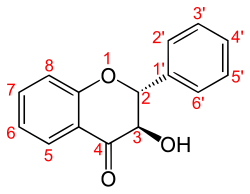Flavanonole

Die Flavanonole (Syn: Dihydroflavonole) sind eine Untergruppe sekundärer Pflanzenstoffe innerhalb der Stoffgruppe der Flavonoide. Sie unterscheiden sich strukturell von dem ihnen zugrunde liegenden Flavan durch eine zusätzliche Hydroxygruppe in Position 3 und eine zusätzliche Ketogruppe in Position 4. Das Grundgerüst der Flavanonole ist somit die Verbindung 3-Hydroxyflavan-4-on.
Struktur
Wie die Flavanole und die Leukoanthocyanidine besitzen die Flavanonole zwei Chiralitätszentren an den Kohlenstoffatomen C2 und C3, so dass es zu einer Konstitutionsformel immer jeweils vier mögliche Konfigurationen gibt: (2R,3R), (2S,3S), (2R,3S) und (2S,3R).[1] Dabei ist bei den Flavanonolen die (2R,3R)-Konfiguration bei weitem die gängigste Konfiguration, aber es gibt Flavanonol-Typen wie beispielsweise die Glycoside Astilbin und Engeletin, für die alle vier möglichen Konfigurationen gefunden wurden.[1][2]
Die einzelnen Flavanonole unterscheiden sich voneinander durch das Substitutionsmuster des 3-Hydroxyflavan-4-on-Grundgerüsts mit Hydroxygruppen und durch die Art der weiteren Derivatisierung dieser hydroxylierten 3-Hydroxyflavan-4-one durch u. a. O-Alkylierung, meist in der Form von O-Methylierung und/oder durch die O-glycosidische Anbindung von Saccharid-Resten unter Bildung von Glycosiden. Weitere Derivatisierungsarten sind C-Alkylierung, Acylierung und die C-glycosidische Anbindung von Saccharid-Resten.[1][3][4]
Nicht-glycosylierte Flavanonole
Die häufigsten Flavanonole sind Aromadendrin, Taxifolin und Ampelopsin. Typisch für die gängigen Flavanonole ist, dass neben der Position 3 am C-Ring auch die Positionen 5 und 7 am A-Ring Hydroxygruppen tragen. Bzgl. der Substitution des B-Rings ist die Hydroxylierung der Positionen 4' (Aromadendrin), 3' und 4' (Taxifolin) bzw. 3', 4' und 5' (Ampelopsin) auch bei anderen Untergruppen der Favonoide gängig.
Aromadendrin
Taxifolin
Ampelopsin
Auch die analogen Flavanonole ohne Hydroxygruppe am Kohlenstoffatom in Position 5 des A-Rings sind bekannt. Diese sind Garbanzol, Fustin und (+)-Dihydrorobinetin.[1]
Von der zu Taxifolin isomeren Verbindung Dihydromorin wurden eine ganze Anzahl von C-alkylierten Derivaten gefunden. Beispielsweise sind bei Kushenol L Prenylreste an die Kohlenstoffatome in den Positionen 6 und 8 gebunden.[4]
Garbanzol
Fustin
Dihydromorin
| Name | Synonym | CAS | Konfig. C2, C3 | 3 | 5 | 6 | 7 | 8 | 2′ | 3′ | 4′ | 5′ | 6′ |
|---|---|---|---|---|---|---|---|---|---|---|---|---|---|
| Ampelopsin | (+)-Dihydromyricetin | 27200-12-0 | (2R,3R) | OH | OH | H | OH | H | H | OH | OH | OH | H |
| Aromadendrin | (+)-Dihydrokaempferol | 480-20-6 | (2R,3R) | OH | OH | H | OH | H | H | H | OH | H | H |
| Dihydromorin | 18422-83-8 | (2R,3R) | OH | OH | H | OH | H | OH | H | OH | H | H | |
| (+)-Dihydrorobinetin | (+)-5-Deoxydihydromyricetin | 4382-33-6 | (2R,3R) | OH | H | H | OH | H | H | OH | OH | OH | H |
| Fustin | Dihydrofisetin | (2R,3R) | OH | H | H | OH | H | H | OH | OH | H | H | |
| 8-Hydroxyfustin | OH | H | H | OH | OH | H | OH | OH | H | H | |||
| Garbanzol | (2R,3R)-5-Deoxy-dihydrokaempferol | 1226-22-8 | (2R,3R) | OH | H | H | OH | H | H | H | OH | H | H |
| Kushenol L | (2R,3R)-6,8-Diprenyldihydromorin | 101236-50-4 | (2R,3R) | OH | OH | Prenyl | OH | Prenyl | OH | H | OH | H | H |
| Pinobanksin | (2R,3R)-Dihydrogalangin | 548-82-3 | (2R,3R) | OH | OH | H | OH | H | H | H | H | H | H |
| Taxifolin | (+)-Dihydroquercetin | 480-18-2 | (2R,3R) | OH | OH | H | OH | H | H | OH | OH | H | H |
| 3'-O-Methyltaxifolin | (+)-Dihydroisorhamnetin | 55812-91-4 | (2R,3R) | OH | OH | H | OH | H | H | OMe | OH | H | H |
Glycosylierte Flavanonole
| Glycosid | Aglycon | CAS | Konfig. C2, C3 | 3 | 5 | 6 | 7 | 8 | 2′ | 3′ | 4′ | 5′ | 6′ |
|---|---|---|---|---|---|---|---|---|---|---|---|---|---|
| Astilbin | (2R,3R)-Dihydroquercetin; Taxifolin | 29838-67-3 | (2R,3R) | Rha | OH | OH | OH | OH | |||||
| Neoastilbin | (2S,3S)-Dihydroquercetin | 54081-47-9 | (2S,3S) | Rha | OH | OH | OH | OH | |||||
| Isoastilbin | (2R,3S)-Dihydroquercetin | 54081-48-0 | (2R,3S) | Rha | OH | OH | OH | OH | |||||
| Neoisoastilbin | (2S,3R)-Dihydroquercetin | (2S,3R) | Rha | OH | OH | OH | OH | ||||||
| Engeletin | (2R,3R)-Dihydrokaempferol; Aromadendrin | 572-31-6 | (2R,3R) | Rha | OH | OH | OH | ||||||
| Neoengeletin | (2S,3S)-Dihydrokaempferol | 54081-49-1 | (2S,3S) | Rha | OH | OH | OH | ||||||
| Isoengeletin | (2R,3S)-Dihydrokaempferol | (2R,3S) | Rha | OH | OH | OH | |||||||
| Neoisoengeletin | (2S,3R)-Dihydrokaempferol | (2S,3R) | Rha | OH | OH | OH | |||||||
| Taxifolin-7-O-glucosid | (2R,3R)-Dihydroquercetin | (2R,3R) | OH | OH | Glc | OH | OH | ||||||
| |||||||||||||
Engeletin
Neoengeletin
Isoengeletin
Neoisoengeletin
Biosynthese
Die Flavanonole werden durch Hydroxylierung der Methylengruppe in Position 3 der entsprechenden Flavanone gebildet. So entstehen aus den Flavanonen Naringenin, Eriodictyol und 3,5,7,3',4',5'-Hexahydroxyflavan-4-on die Flavanonole Aromadendrin, Taxifolin und Ampelopsin. Die Reaktion wird durch Flavanon-3-Hydroxylasen katalysiert. Die Flavanonole selbst sind Vorläufer der Flavonole, der Anthocyanidine und der Flavanole.[3][5][6]
Einzelnachweise
- ↑ a b c d Bohm B. A.: Introduction to Flavonoids - Chemistry and biochemistry of organic natural products; Volume 2, 1999, Verlag CRC Press, S. 80–82, ISBN 90-5702-353-9
- ↑ Shi, H. et al.: Separating four diastereomeric pairs of dihydroflavonol glycosides from Engelhardia roxburghiana using high performance counter-current chromatography Journal of Chromatography A, 2015, 1383, S. 79–87, doi:10.1016/j.chroma.2015.01.024
- ↑ a b Peter Nuhn: Naturstoffchemie. 3. Auflage. S. Hirzel, Stuttgart/Leipzig 1997, ISBN 3-7776-0613-8, S. 602–605.
- ↑ a b Harborne J. B.: The Flavonoids - Advances in Research since 1980, 1988, Chapman and Hall, London, New York S. 372–379, ISBN 0-412-28770-6
- ↑ Schütte, H.-R.: Secondary Plant Substances Flavonoid Biosynthesis and their Regulation, In: Ellenberg, H., Esser, K., Merxmüller, H., Schnepf, E., Ziegler, H. (eds): Fortschritte der Botanik, Progress in Botany, 1974, Vol 36. Springer, Berlin, Heidelberg, S. 108–123, ISBN 978-3-540-07036-8, doi:10.1007/978-3-662-12810-7_10
- ↑ Yu, Z. W. et al.: Exploring the genes involved in biosynthesis of dihydroquercetin and dihydromyricetin in Ampelopsis grossedentata Scientific Reports, 2021, 11(1), 15596, doi:10.1038/s41598-021-95071-x
Auf dieser Seite verwendete Medien
Chemical diagram for isoengeletin
Garbanzol; 3,7,4'-Trihydroxyflavanone
Grundstruktur eines Flavanonols
Struktur von (+)-Taxifolin
(+)-aromadedrin; (+)-Dihydrokaempferol; Aromadendrol; Aromadedrin;
Fustin; 2,3-Dihydrofisetin
Structure of dihydromorin
(+)-ampelopsin; (+)-Dihydromyricetin
Chemical diagram for neoengeletin
Chemical diagram for engeletin
Chemical diagram for neoisoengeletin




















